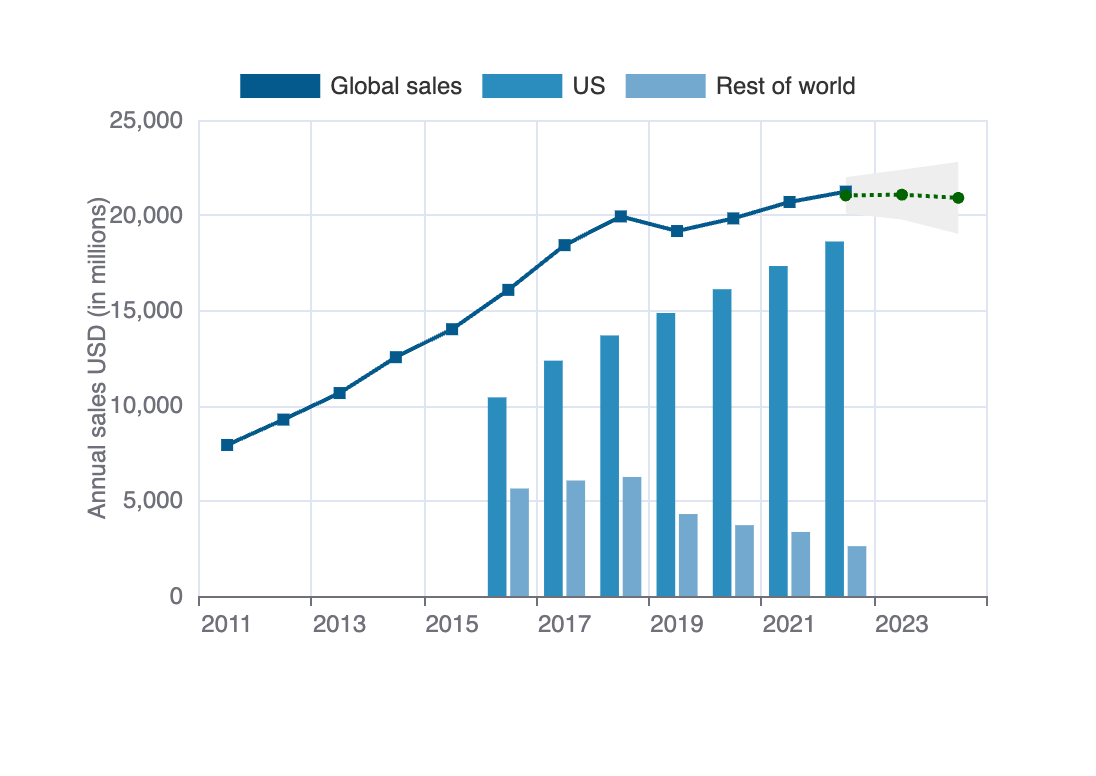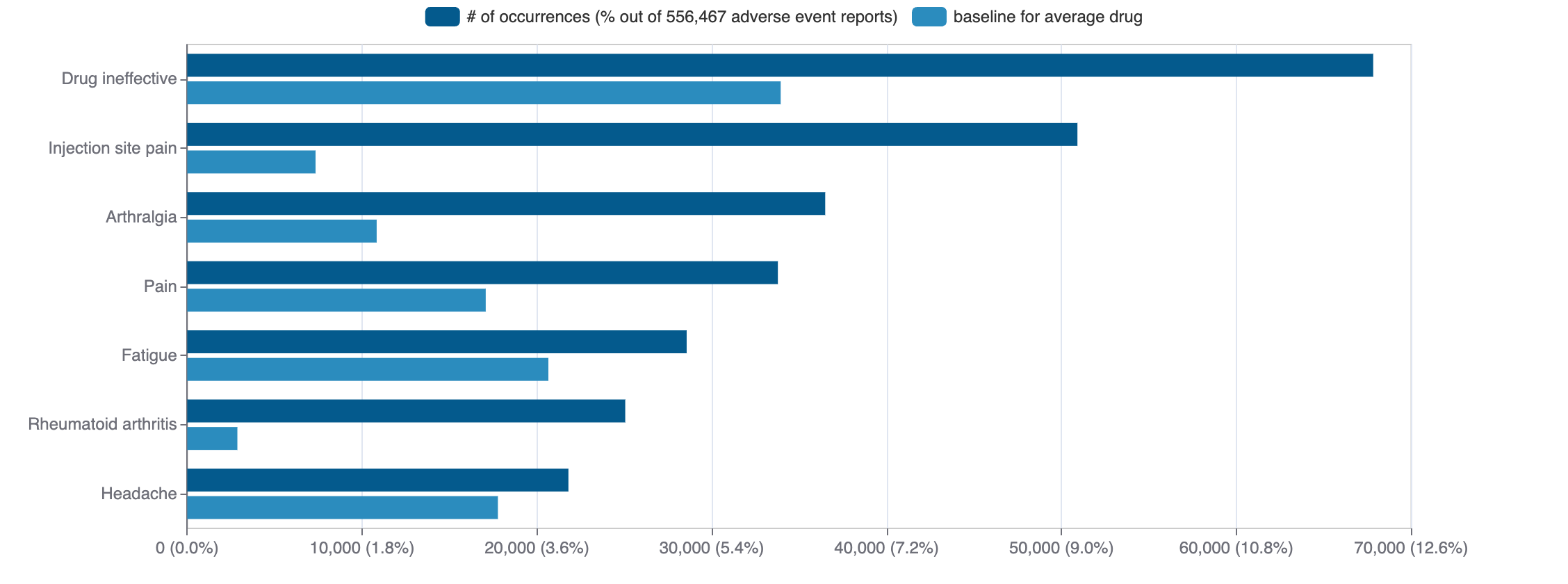Calquence(acalabrutinib)
Calquence (acalabrutinib) is a small molecule pharmaceutical. Acalabrutinib was first approved as Calquence on 2017-10-31. It is used to treat mantle-cell lymphoma in the USA. It has been approved in Europe to treat b-cell chronic lymphocytic leukemia. The pharmaceutical is active against tyrosine-protein kinase BTK. In addition, it is known to target tyrosine-protein kinase Fyn, receptor tyrosine-protein kinase erbB-2, epidermal growth factor receptor, tyrosine-protein kinase Blk, tyrosine-protein kinase JAK3, tyrosine-protein kinase ITK/TSK, proto-oncogene tyrosine-protein kinase Src, cytoplasmic tyrosine-protein kinase BMX, tyrosine-protein kinase Tec, tyrosine-protein kinase TXK, tyrosine-protein kinase Lyn, tyrosine-protein kinase Lck, and receptor tyrosine-protein kinase erbB-4.
Download report
Favorite
COVID-19
Commercial
Trade Name
FDA
EMA
Calquence
Drug Products
FDA
EMA
New Drug Application (NDA)
New Drug Application (NDA)
Abbreviated New Drug Application (ANDA)
Abbreviated New Drug Application (ANDA)
Labels
FDA
EMA
Brand Name | Status | Last Update |
|---|---|---|
| calquence | New Drug Application | 2022-03-23 |
Agency Specific
FDA
EMA
Expiration | Code | ||
|---|---|---|---|
ACALABRUTINIB, CALQUENCE, ASTRAZENECA | |||
| 2026-11-21 | ODE-274 | ||
| 2024-10-31 | ODE-175 | ||
Patent Expiration
Patent | Expires | Flag | FDA Information |
|---|---|---|---|
| Acalabrutinib, Calquence, Astrazeneca | |||
| 9796721 | 2036-07-01 | DS, DP | U-2145, U-2666, U-2667, U-2668, U-2669, U-2670, U-2671 |
| 10167291 | 2036-07-01 | DP | U-2145, U-2666, U-2667, U-2668, U-2669, U-2670, U-2671 |
| 10272083 | 2035-01-21 | U-2519, U-2682, U-2683, U-2684, U-2685, U-2686, U-2687 | |
| 9290504 | 2032-07-11 | DS, DP | |
| 9758524 | 2032-07-11 | U-2145 | |
| 10239883 | 2032-07-11 | U-2666, U-2668 | |
| 7459554 | 2026-11-24 | DP | |
| Acalabrutinib Maleate, Calquence, Astrazeneca | |||
| 11059829 | 2036-07-01 | DS, DP | U-2145, U-2666, U-2667, U-2668, U-2669, U-2670, U-2671 |
HCPCS
No data
Clinical
Clinical Trials
127 clinical trials
View more details

Mock data
Subscribe for the real data
Subscribe for the real data
Indications Phases 2
Indication | MeSH | Ontology | ICD-10 | Ph 1 | Ph 2 | Ph 3 | Ph 4 | Other | Total |
|---|---|---|---|---|---|---|---|---|---|
| Non-hodgkin lymphoma | D008228 | C85.9 | 7 | 8 | — | — | — | 10 | |
| Follicular lymphoma | D008224 | C82 | 3 | 5 | — | — | — | 6 | |
| Waldenstrom macroglobulinemia | D008258 | C88.0 | 1 | 5 | — | — | — | 5 | |
| Reactive arthritis | D016918 | EFO_0007460 | M02.3 | 3 | 5 | — | — | — | 5 |
| Multiple myeloma | D009101 | C90.0 | 3 | 2 | — | — | — | 3 | |
| Lymphoma | D008223 | C85.9 | 3 | 2 | — | — | — | 3 | |
| Prolymphocytic leukemia | D015463 | 2 | 1 | — | — | — | 2 | ||
| Pancreatic neoplasms | D010190 | EFO_0003860 | C25 | — | 2 | — | — | — | 2 |
| B-cell lymphoma | D016393 | 1 | 1 | — | — | — | 1 | ||
| Rheumatoid arthritis | D001172 | EFO_0000685 | M06.9 | — | 1 | — | — | — | 1 |
Show 17 more
Indications Without Phase
No data
Epidemiology
Epidemiological information for investigational and approved indications
View more details
Drug
General
| Drug common name | ACALABRUTINIB |
| INN | acalabrutinib |
| Description | Acalabrutinib is a member of the class of imidazopyrazines that is imidazo[1,5-a]pyrazine substituted by 4-(pyridin-2-ylcarbamoyl)phenyl, (2S)-1-(but-2-ynoyl)pyrrolidin-2-yl, and amino groups at positions 1, 3 and 8, respectively. It is an irreversible second-generation Bruton's tyrosine kinase (BTK) inhibitor that is approved by the FDA for the treatment of adult patients with mantle cell lymphoma (MCL) who have received at least one prior therapy. It has a role as an EC 2.7.10.2 (non-specific protein-tyrosine kinase) inhibitor, an antineoplastic agent and an apoptosis inducer. It is a secondary carboxamide, a member of benzamides, a member of pyridines, an aromatic amine, a pyrrolidinecarboxamide, an imidazopyrazine, a ynone and a tertiary carboxamide. |
| Classification | Small molecule |
| Drug class | tyrosine kinase inhibitors: tyrosine kinase inhibitors Bruton's (Btk) inhibitors |
| Image (chem structure or protein) | |
| Structure (InChI/SMILES or Protein Sequence) | CC#CC(=O)N1CCC[C@H]1c1nc(-c2ccc(C(=O)Nc3ccccn3)cc2)c2c(N)nccn12 |
Identifiers
| PDB | — |
| CAS-ID | 1420477-60-6 |
| RxCUI | 1986808 |
| ChEMBL ID | CHEMBL3707348 |
| ChEBI ID | — |
| PubChem CID | 71226662 |
| DrugBank | DB11703 |
| UNII ID | I42748ELQW (ChemIDplus, GSRS) |
Target
Agency Approved
BTK
BTK
Organism
Homo sapiens
Gene name
BTK
Gene synonyms
AGMX1, ATK, BPK
NCBI Gene ID
Protein name
tyrosine-protein kinase BTK
Protein synonyms
agammaglobulinaemia tyrosine kinase, Agammaglobulinemia tyrosine kinase, ATK, B-cell progenitor kinase, BPK, Bruton agammaglobulinemia tyrosine kinase, Bruton tyrosine kinase, Bruton's tyrosine kinase, dominant-negative kinase-deficient Brutons tyrosine kinase
Uniprot ID
Mouse ortholog
Btk (12229)
tyrosine-protein kinase BTK (Q61365)
Alternate
FYN
FYN
ERBB2
ERBB2
EGFR
EGFR
BLK
BLK
JAK3
JAK3
ITK
ITK
SRC
SRC
BMX
BMX
TEC
TEC
TXK
TXK
LYN
LYN
LCK
LCK
ERBB4
ERBB4
Organism
Homo sapiens
Gene name
FYN
Gene synonyms
NCBI Gene ID
Protein name
tyrosine-protein kinase Fyn
Protein synonyms
c-syn protooncogene, FYN oncogene related to SRC, FGR, YES, OKT3-induced calcium influx regulator, p59-Fyn, Proto-oncogene c-Fyn, Proto-oncogene Syn, SLK, Src-like kinase, src/yes-related novel, tyrosine kinase p59fyn(T)
Uniprot ID
Mouse ortholog
Fyn (14360)
tyrosine-protein kinase Fyn (P39688)
Variants
Clinical Variant
No data
Financial
Calquence - AstraZeneca
$
€
£
₣

Mock data
Subscribe for the real data
Subscribe for the real data

Mock data
Subscribe for the real data
Subscribe for the real data
Tabular view
Trends
PubMed Central
Top Terms for Disease or Syndrome:

Mock data
Subscribe for the real data
Subscribe for the real data
Additional graphs summarizing 1,871 documents
View more details
Safety
Black-box Warning
No Black-box warning
Adverse Events
Top Adverse Reactions

Mock data
Subscribe for the real data
Subscribe for the real data
5,354 adverse events reported
View more details
Premium feature
Learn more about premium features at pharmakb.com
Learn more
